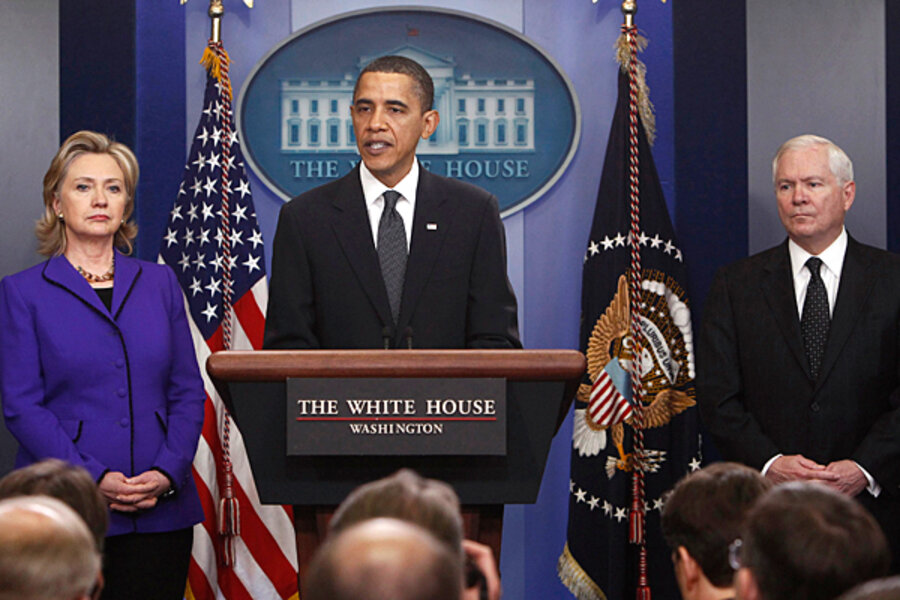Nuclear weapons-free world: a vision of Kennedy, Reagan, Obama
Loading...
| Washington
US-Russia agreement on a new treaty to reduce nuclear weapons is being hailed as President Obama’s first real foreign-policy victory and a personal triumph for a leader who envisions a nuclear-weapons-free world.
But that vision stretches back at least as far as President John Kennedy, and actually came tantalizingly close to fruition under President Ronald Reagan.
Indeed, many nuclear disarmament advocates share a sense that the treaty Mr. Obama announced Friday is the first step of many toward a nuclear-free world, given the long-standing and “centrist” support behind nuclear-weapons reduction and elimination.
“This vision of a world without the Damocles sword of nuclear weapons hanging over it, as John Kennedy said, is one whose time has come,” says Joseph Cirincione, president of the Ploughshares Fund, a Washington organization that supports initiatives designed to prevent the spread and use of nuclear, biological, and chemical weapons. “It’s the fact that the idea of moving in this direction is one shared by conservatives and moderates as well as liberals that is giving it such strength.”
START's broader importance
The weapons reductions called for in the follow-on START (Strategic Arms Reduction Treaty) accord, to be signed April 8 in Prague, Czech Republic, are themselves not that revolutionary, most disarmament experts say. Russia and the US were already both headed in the direction outlined by the treaty’s warheads and delivery-systems reductions, they say.
The treaty's broader importance lies in its tone and the direction it sets at a time of rising interest in nuclear-arms reduction and of international steps to advance the vision of a nuclear-weapons-free world. Obama hosts a summit of 44 heads of state in Washington in April to focus on nuclear-materials security. Then, in May, the United Nations holds a five-year review meeting of the Nuclear Nonproliferation Treaty (NPT).
The last NPT review conference occurred under an unenthusiastic Bush administration. But the new START should give a boost to the NPT’s underlying quid pro quo: weapons reductions by nuclear powers (the US and Russia have more than 90 percent of the world’s nuclear warheads) in exchange for nonnuclear powers verifiably foregoing nuclear weapons in exchange for civilian nuclear energy uses.
First Kennedy, then Reagan, now Obama
It was before the United Nations, in the depths of the cold war, that Kennedy ventured to envision a world free of the nuclear threat. Then, Ronald Reagan –the same president who had been vilified by nuclear-freeze advocates because of his arms buildup – stunned the world by coming close to an accord with Soviet President Mikhail Gorbachev to destroy all nuclear weapons within 10 years.
The two leaders came within a word of reaching a no-nukes accord – that word being “laboratory,” Mr. Cirincione says. He says Mr. Gorbachev insisted that Reagan’s “star wars” missile defense project be limited to laboratory research, but Reagan said no and a deal fell through.
But the vision stuck with Reagan’s secretary of State, George Shultz. It was he who emboldened a little-known Democratic senator from Illinois named Barack Obama, when Mr. Schulz joined another Republican diplomatic icon and two prominent Democrats in 2007 to promote the idea of a nuclear-weapons-free world.
“It was really the Jan. 7, 2007, Wall Street Journal op-ed by Schulz, Henry Kissinger, Sam Nunn, and William Perry that put the idea of eliminating nuclear weapons back on the map,” Cirincione says. “You can trace the push in this direction from Obama as a political leader from there,” he adds. “And it’s the impeccably bipartisan and centrist nature of the position they laid out that has allowed it to prosper.”
Will the Senate ratify?
Can the vision of eliminated nuclear weapons survive in a polarized Washington? The new START, a 10-year treaty, will require Senate ratification, and by a two-thirds majority, or 67 senators – eight more than the Democrats’ 59.
The White House took as a good sign a statement from Sen. Richard Lugar (R) of Indiana, ranking member of the Senate Foreign Relations Committee, that he expects to “work quickly to achieve ratification of this new treaty.”
Several Republican senators, including John Kyl of Arizona and minority leader Mitch McConnell of Kentucky, had said previously that ratification would fail if the new treaty contained limits on US missile defense programs. The Obama administration has said it does not. (President Obama had already announced modifications to Bush-era missile defense plans that addressed a number of Russia's concerns.)
The biggest threat to the treaty, and the larger goal of a no-nukes world, may be those who argue that it is too pie-in-the-sky for a world of multiple nuclear powers and nuclear wannabes – including the likes of Iran and North Korea.
“There’ll be some opposition from the nuclear hawks, but the real resistance is going to come from the cynics who have no particular interest in nuclear weapons but who believe eliminating them is undesirable or unrealistic or can’t be done by this administration,” Cirincione says. “That kind of cynicism could be quite crippling.”





